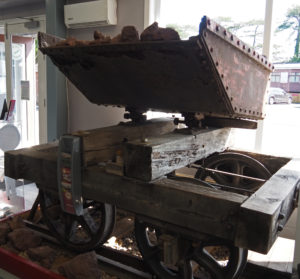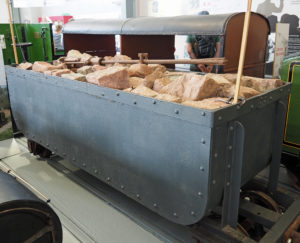This is a fascinating small museum in what was the former Furness Railway platform shelter on Ravenglass main line station. The building was redesigned and extended as a display shed for locomotives and rolling stock as well as many artefacts connected to the history and working of the line. There is also an exhibition gallery with rotating exhibitions from the local community.
As well as the exhibits there are many information boards to read. Allow plenty of time – at least an hour if possible. I had only 20 minutes and couldn’t begin to do justice to the museum.
The highlight of the collection must be the steam locomotives – Katie, Synolda and Little Giant. Katie was built in 1896 and worked on the Ravenglass and Eskdale railway from 1915-19 was mainly used for freight, only taking passengers on busy days. She had a small boiler and had to stop frequently to raise more steam. Passengers used to get off and pick flowers or heather. She has been restored to working order and used for special events.
Synolda was built by Bassett-Lowke in 1912 and is similar to other locos built by them to run on the Ravenglass and Eskdale Railway. She is painted in 1915 livery. Although in working order, she is too light for normal operation and only used on special occasions.
Little Giant is another Bassett-Lowke loco and was built in 1905.
A sectioned boiler from River Esk demonstrates how a steam engine works.
Other locos include ICL No.1 Bunny which was made from parts of a Crewe Tractor converted car that blew up. From 1927, it worked the daily passenger trains during the winter months. It was heavy on petrol and rarely ran after the 1950s. It holds the railway speed record, having made the down trip in just 15 minutes.
Near this is Quarryman , another tractor engine built in 1927 and used to carry granite from Beckfoot quarry. It was still in use until 1980.
There are examples of the different tools used in building the railway. Much of the work was done by hand. Many of the early mine workings were connected to the railway by inclines and there are the remains of the cable and wheels used to lower loaded wagons by gravity and pull the empties back up. There are also examples of the different types of wagons used to bring iron ore from the mines at boot and granite from the quarries at Beckfoot as well as wagons carrying household goods up the line.
There is also an example of the wooden open Bassett Lowke coach which carried passengers on the reopening of the railway in 1915. It can rain a lot in the Lake District, so later open coaches were provided with a roof.
There is very good disables access to the museum.
There are more pictures at #6
“here.”:https://www.sloweurope.com/community/threads/ravenglass-and-eskdale-railway-cumbria.6016/
“Website”:http:// https://ravenglassrailwaymuseum.co.uk/










